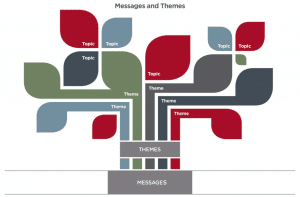
Every good general knows you don’t go into battle without a well-planned strategy, and the same goes for your business (well, maybe the stakes aren’t quite as high.)
While your content marketing plan might not be supporting life-or-death decision-making, it could end up being the only thing standing between your marketing goals and a lot of wasted time, effort, and resources.
Successful marketing is all about planning the work, and then working your plan. But according to MarketingProfs and CMI, only 41 percent of B2B marketers have a documented content marketing strategy in place, while another 19 percent plan to create one within the next 12 months. Don’t wait 12 months, marketer. Get to work on your planning now.
A good content marketing plan isn’t only about content, but that part is critically important. I’ve been helping companies weave content strategy into plans for years at Right Source Marketing. Regardless of how elaborate (or simple) your planning ends up being, you need a system to make sure that you don’t just end up with five blog post ideas scribbled down on a napkin.
To make sure you have as much of a plan for your content creation as you do for the rest of your marketing efforts, build a framework of messages, themes, and topics. This ensures that you have something to go back to when the well runs dry and you are foggy about the path forward. A solid plan for content strategy and execution is the difference between you just adding to the chaos out there in the content world — and success.
Here’s how to work out messages, themes, and topics for your plan—it might just save your content marketing effort.
Grow a Content Tree
You can think of the hierarchy between messages, themes, and topics like a tree. Your messages (the important points that differentiate your company) are the roots buried deep, creating a foundation for the rest of your content. The tree branches are content themes (think idea buckets or content areas), and from each one of those theme branches grows a whole bunch of leaves that are your topics.

Think of your messages as the bedrock. You will create content with them in mind, always circling back to their points with your topics, calls to action, and advice. Themes give your content direction and address your ultimate marketing and company goals, and the topics bring messages and themes to life by demonstrating targeted thought leadership.
Of course, like real trees, some branches will have more leaves than others. Similarly, some themes will produce more topic leaves than others as you highlight the most important pain points for your customers or focus on industry trends. But, ultimately, themes and topics should all fit into this broader “tree” framework.
Start with succinct, differentiating messages
Every company should have a messaging guide, whether you have a documented content marketing plan or not. But if you’re going to put a plan together, you absolutely need to have your company’s messaging — its story — down.
Let’s start with the anatomy of a well-crafted message. A good message is a succinct combination of what you do, what your brand/company believes in/stands for, and why your company is different from the others that might do something very similar.
A well-written message should be brief and direct. Avoid confusion and complexity and make certain that each message communicates one important point.
Messages are not the place to throw in everything and the kitchen sink because you believe there is SO much that is important about your company. I’m quite sure there is, but messages sum up the unique characteristics and convey just the critical aspects of the differentiator. Each makes one point, not 12.
To help keep yourself on track in drafting your messages, keep them to between 30 and 50 words each. You should also think of your messages as being intended for an internal audience. Each message is a guiding principle to build the rest of your content. While messages are not likely to be used in content verbatim, they should be seen as the foundation of the content — ideas that you should be circling back to consistently.
For example:
Let’s look at the both wildly successful and fictitious telehealth company, “Medicine & Doctors Online” (M&DO).
M&DO might have messages in its content plan that look like the ones below. Note how each describes what makes the company unique or explains how it might be different from other firms that compete in the same space:
- M&DO is part of Video Conference, Inc., one of the first companies to enter the virtual communications space more than a decade ago. As a result, M&DO has the advantage of years of experience in providing virtual meeting and communications and solving associated problems that some competitors have never even encountered.
- Unlike many telehealth companies, M&DO’s engineers all have healthcare experience. They understand the unique needs of the IT side of healthcare organizations and work with those teams to make sure all implementation goes smoothly.
- M&DO’s platforms allow clinicians simple access to video conferencing and streamlined integration with M&DO’s companion EHR. Since the systems were designed to work together, there are no interoperability problems for users or IT departments.
- M&DO’s products are secure and HIPPA compliant. Both providers and patients have access to a safe and private platform, a cornerstone of what M&DO provides.
Here you can see how these probably aren’t appropriate to put directly in marketing materials, but they are direct and get at the core of why M&DO is the right choice for customers. Now that we have a foundation that relates to marketing and company objectives, let’s talk about how we organize content and the ideation process: building out content themes.
Expanding into themes
The themes you create will guide all of the topic choices you make for the year. Themes are generated from a mixture of knowledge about marketing and business goals, discussions with sales, competitive and industry research, and conversations with customers or prospects, and stem from the compelling messages you just created.
You might decide to create themes under service areas for your business. You may create themes that align more with the goals or desires of your audience(s). Ask yourself, “is the content I create under each of these themes going to address the goal of X in some way?” If you can’t figure out how the answer might be yes, then maybe that’s not the right theme to support your content strategy, and therefore business goals.
The other thing you MUST be able to do for each theme is create a wealth of content under each. A theme is not a topic. Think of it as a topic area. As long as you can create enough topics related to each theme that drive toward your marketing goals — and have faith that you can generate more if you run out during the year — you have a solid theme and you will remain organized and hopefully be successful.
So, going back to our Consultants & Product Developers example, it might have “theme branches” like:
- Project planning and management
- Trends in the engineering world
- Selecting an engineering firm
Executing on topics
Topics are the individual ideas that support each theme: Each theme branch, such as project planning and management, would have lots of leaves growing from it that can represent the many pieces of content you will create.
Our example company, C&PD, can probably create 10 blog posts in a year on project planning or best practices in project management that fit squarely under their project planning and management theme. The same thing can be done for other themes. You just keep adding “leaves” when you run out of topics.
Having done all of this work around messages and themes before you even start thinking about topics means you have a framework in which to brainstorm if you get stuck during the year. Consider if C&PD had exhausted all of its preplanned blog post ideas for the year. Because the company did the planning work to create a strategy with messages and themes, it has a foundation to work from.
And there are helpful tools that can get you unstuck if you have an idea of what you should be organizing your content around. Check out, for example, Hubspot’s blog idea generator. When you get stuck, but have done careful planning around themes, you can use something like this to populate new ideas that fit within your content strategy.
Here you can see how I started with just the keywords from one of C&PD’s themes in order to generate some new topics for my tree:

And just like that, I’m presented with a whole list of ideas that can begin to fill the holes in my content strategy because they are built around a theme.

While these may not be perfect, having a plan in place means you can use this kind of nifty tool, as well as the extra brains on your team, to have a conversation that will get your creative juices flowing in a direction that supports your broader strategy.
Congrats, you have a plan!
Messages, themes, and topics might seem like just the creative part of your content marketing plan, but it’s just as critical, and requires just as much planning, as any other area. Think about the big picture, use the “tree logic,” develop themes to keep content on track and headed toward your marketing and business goals all year long — and then put it all into your editorial calendar!
Are you struggling to get your content marketing program off the ground? Download “Build Your Content Marketing Plan: A 10-Step Guide” for the pointers you need.
Still stuck? Let us help you out.
Editor’s Note: This post was originally published February 2016 and has been thoroughly updated for comprehension and accuracy.



